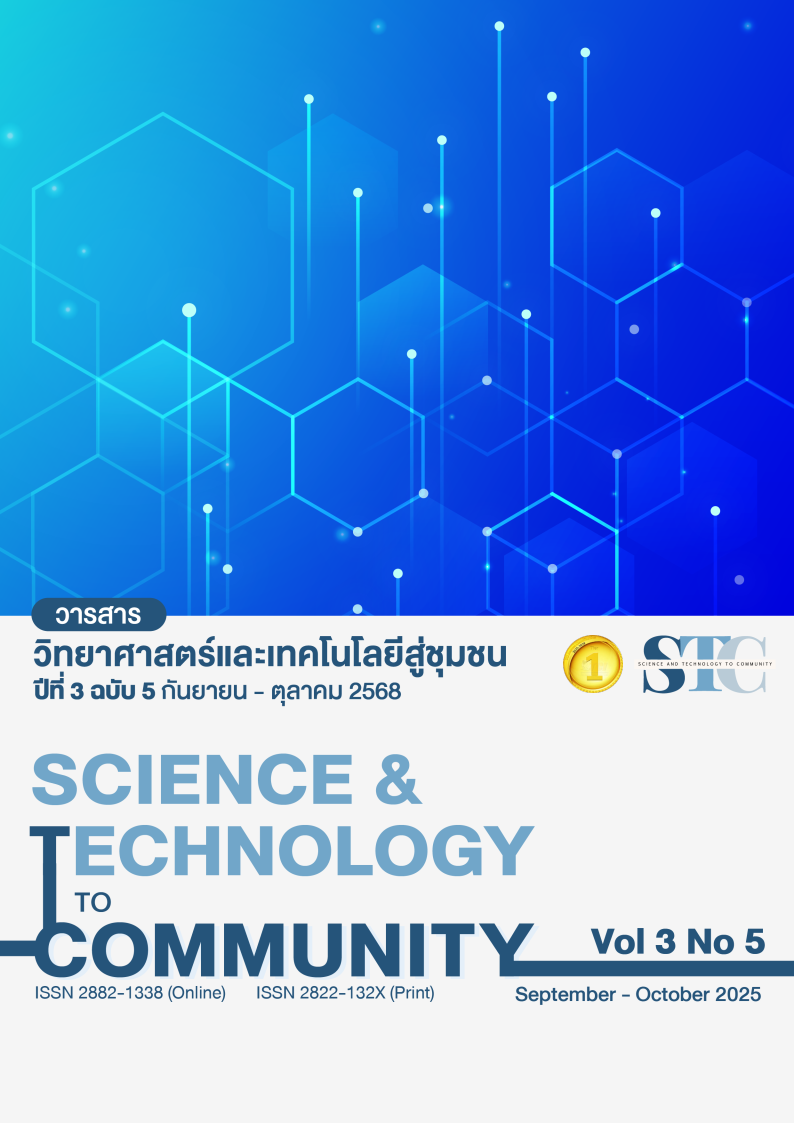Optimizing Parameter Estimation in Holt–Winters and Decomposition Methods Using the Cuckoo Search Algorithm : Forecasting Monthly Water Inflow into Large-Dam Reservoirs in Central and Western Thailand
DOI:
https://doi.org/10.57260/stc.2025.1089Keywords:
Time series, Forecasting, Dam reservoir, Cuckoo search optimizationAbstract
This study aims to evaluate the performance of models that integrate the Cuckoo Search (CS) algorithm with the Holt-Winters method (CS-HW) and the Decomposition method (CS-D) for forecasting the monthly water inflow into five large dam reservoirs located in the central and western regions of Thailand. The models were compared with two commonly used software packages, Minitab (Minitab-D) and Excel (ForecastSheet-HW). In the training phase, CS-HW and CS-D showed lower Mean Absolute Error (MAE) than the software-based approaches, indicating a greater capacity to optimize parameter estimation.
In the testing phase, the model with the lowest MAE was selected for each reservoir. Specifically, ForecastSheet-HW was chosen for the Srinagarind Dam, CS-HW for the Vajiralongkorn, Kra Siao, and Thap Salao Dams, and Minitab-D for the Pa Sak Cholasit Dam. When employing the selected models to forecast 24 months ahead, all five reservoirs exhibited a distinct seasonal pattern, with peak inflows occurring in the rainy season (August–October). The findings highlight that integrating a metaheuristic algorithm such as CS with traditional time series models can enhance forecasting accuracy, offering valuable support for future water resource management planning.
Downloads
References
กรมชลประทาน. (2568). ระบบฐานข้อมูลน้ำในอ่างเก็บน้ำ กรมชลประทาน. https://app.rid.go.th/reservoir/
วฐา มินเสน. (2567). เอกสารคำสอนการวิเคราะห์อนุกรมเวลา. คณะวิทยาศาสตร์ มหาวิทยาลัยเชียงใหม่.
Dorigo, M. (1992). Optimization, Learning and Natural Algorithms. Ph.D. thesis, Politecnico di Milano, Italy.
Dorigo, M., Birattari, M., & Stutzle, T. (2006). Ant colony optimization. IEEE Comput Intell, 1(4), 28–39. https://doi.org/10.1109/MCI.2006.329691
Gandomi, A. H., & Alavi, A. H. (2012). Krill herd: a new bio-inspired optimization algorithm. Communications in Nonlinear Science and Numerical Simulation, 17(12), 4831-4845. https://doi.org/10.1016/j.cnsns.2012.05.010
Geem, Z. W., Kim, J. H., & Loganathan, G. V. (2001). A new heuristic optimization algorithm: harmony search. Simulation, 76(2), 60-68. https://doi.org/10.1177/003754970107600201
Heidari, A. A., Mirjalili, S., Faris, H., Aljarah, I., Mafarja, M., & Chen, H. (2019). Harris hawks optimization: Algorithm and applications. Future Generation Computer Systems, 97, 849-872. https://doi.org/10.1016/j.future.2019.02.028
Jiang, W., Wu, X., Gong, Y., Yu, W., & Zhong, X. (2020). Holt–Winters smoothing enhanced by fruit fly optimization algorithm to forecast monthly electricity consumption. Energy, 193, 116779. https://doi.org/10.1016/j.energy.2019.116779
Kaewpaengjuntra, S., Somhom, S., & Saenchan, L. (2010). Electricity consumption forecasting model using hybrid Holt-Winters exponential smoothing and artificial bee colony algorithm. Information Technology Journal, 6(1), 12-17. https://ph01.tci-thaijo.org/index.php/IT_Journal/article/view/73218
Karaboga, D. (2005). An Idea Based on Honey Bee Swarm for Numerical Optimization (Technical Report No. TR06). Erciyes University, Engineering Faculty, Computer Engineering Department. https://abc.erciyes.edu.tr/pub/tr06_2005.pdf
Kennedy, J., & Eberhart, R. (1995). Particle Swarm Optimization. In 1995 IEEE
International Conference on Neural Networks (ICNN’95) (pp. 1942–1948). IEEE. https://doi.org/10.1109/ICNN.1995.488968
Mauricio, C. C., & Ostia, C. F. (2023). Cuckoo search algorithm optimization of holt-winter method for distribution transformer load forecasting. In 9th International Conference on Control, Automation and Robotics (ICCAR) (pp. 36-42), Beijing, China. https://doi: 10.1109/ICCAR57134.2023.10151700
Minsan, W., & Minsan, P. (2023). Incorporating decomposition and the Holt-Winters method into the whale optimization algorithm for forecasting monthly government revenue in Thailand. Science & Technology Asia, 28(4), 38–53. https://ph02.tci-thaijo.org/index.php/SciTechAsia/article/view/250335
Minsan, P., & Minsan, W. (2024a). Decomposition and Holt-Winters techniques enhanced by whale optimization algorithm: case study of pm2.5 forecasting in 8 northern provinces of Thailand. Thai Science and Technology Journal, 32(6), 12-34. https://li01.tci-thaijo.org/index.php/tstj/article/view/261071
Minsan, W., & Minsan, P. (2024b). Decomposition and Holt-Winters enhanced by the whale optimization algorithm for forecasting the amount of water inflow into the large dam reservoirs in southern Thailand. Journal of Current Science and Technology, 14(2), article 38. https://doi.org/10.59796/jcst.V14N2.2024.38
Minsan, P., & Minsan, W. (2024c). Monthly volumes of water inflow into the large dam reservoirs in eastern Thailand forecasting by the cuckoo search optimization enhanced decomposition and Holt-Winters techniques. Thai Journal of Operations Research, 12(2), 69-89. https://ph02.tci-thaijo.org/index.php/TJOR/article/view/253542
Minsan, W., Minsan, P., & Panichkitkosolkul, W. (2024). Enhancing decomposition and Holt-Winters weekly forecasting of pm2.5 concentrations in Thailand’s eight northern provinces using the cuckoo search algorithm. Thailand Statistician, 22(4), 963–985. https://ph02.tci-thaijo.org/index.php/thaistat/article/view/256084
Minsan, P., & Minsan, W. (2025a). Forecasting rainfall in the Ping, Wang, Yom, and Nan River Basins of Thailand using decomposition and holt-winters methods enhanced by GRG nonlinear optimization. ASEAN J Sci Tech Report, 28(5), e259297. https://doi.org/10.55164/ajstr.v28i5.259297
Minsan, W., & Minsan, P. (2025b). GRG-HW and GRG-D optimization models for rainfall forecasting in the Yom river basin. figshare. Dataset. https://doi.org/10.6084/m9.figshare.28953389.v2
Mirjalili, S. (2016). Dragonfly algorithm: a new meta-heuristic optimization technique for solving single-objective, discrete, and multi-objective problems. Neural Computing and Applications, 27, 1053-1073. https://doi.org/10.1007/s00521-015-1920-1
Mirjalili, S., & Lewis, A. (2016). The whale optimization algorithm. Advances in Engineering Software, 95, 51-67. https://doi.org/10.1016/j.advengsoft.2016.01.008
Mirjalili, S., Mirjalili, S. M., & Lewis, A. (2014). Grey wolf optimizer. Advances in Engineering Software, 69, 46–61. https://doi.org/10.1016/j.advengsoft.2013.12.007
Pan, W. T. (2012). A new fruit fly optimization algorithm: taking the financial distress model as an example. Knowledge-Based Systems, 26, 69-74. https://doi.org/10.1016/j.knosys.2011.07.001
Vimolsutjarit, N., Minsan,W., Taninpong, P., & Thumronglaohapun, S. (2025). Forecasting Water Volume of Dam Reservoirs in Northern Thailand Using a Classical Decomposition and Holt-Winters Enhanced by Fruit Fly Optimization Algorithm. KKU Science Journal, 53(2), 205–218. https://ph01.tci-thaijo.org/index.php/KKUSciJ
Yang, X. S. (2009). Firefly Algorithms for Multimodal Optimization. In proceedings of 5th international symposium, SAGA 2009 Sapporo, Japan. https://doi.org/10.1007/978-3-642-04944-6_14
Yang, X. S. (2010). A New Metaheuristic Bat-Inspired Algorithm. In proceedings of nature inspired cooperative strategies for optimization (NICSO 2010). Berlin, Heidelberg: Springer Berlin Heidelberg. https://doi.org/10.1007/978-3-642-12538-6_6
Yang, X. S. (2012). Flower Pollination Algorithm for Global Optimization. In proceedings of unconventional computation and natural computation, Lecture notes in computer science. (pp. 240-249). https://doi.org/10.1007/978-3-642-32894-7_27
Yang, X. S., Deb, & S. (2009). Cuckoo Search Via Lévy Flights. In 2009 World Congress on Nature & Biologically Inspired Computing (NaBIC) (pp. 210–214). IEEE. https://doi.org/10.1109/NABIC.2009.5393690
Downloads
Published
How to Cite
Issue
Section
License
Copyright (c) 2025 Science and Technology to Community

This work is licensed under a Creative Commons Attribution-NonCommercial-NoDerivatives 4.0 International License.
1. Articles, information, content, images, etc. that are published in "Science and Technology for Community Journal" is the copyright of science and Technology for Community Journal. Chiang Mai Rajabhat University. If any person or organization wants to distribute all or any part of it or do any action Must have written permission from the science and Technology for Community Journal, Chiang Mai Rajabhat University.
2. Content of articles appearing in the journal is the responsibility of the author of the article. The journal editor is not required to agree or take any responsibility.














